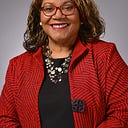One Year Pandemic Anniversary: A Story of Personal Community Outreach
Dr. Rhonda Johnson — Survive COVID-19!
https://www.youtube.com/channel/UCom_B8Wj5txTJTYY6sb8CcQ
March 12, 2020
I had recently returned from a two-week mission trip to Kenya. My first time visiting that beautiful East African nation. Our visit included an orphanage in rural Bomet, Kenya and a tour of the Tenwick Hospital, a ministry of World Gospel Mission and Africa Gospel Church. Although two weeks had transpired, I was still processing the impact of seeing so many orphaned children, whose parents had died from HIV/AIDS; and learning of the impact that HIV/AIDS was having in sub-Saharan Africa.
I am active on social media, then mostly Facebook, and I had been reading the many posts that were common during the early days as the coronavirus was silently spreading “that black people would not get COVID-19.” With my professional expertise in addressing racial disparities in health and advancing health equity, I realized that this rumor needed quick correction, as black Americans were disproportionately affected by chronic disease and socioeconomic realities that would likely lead to a catastrophic, unequal coronavirus disease burden and death toll — which soon became reality. As a pediatrician who had practiced in many socially vulnerable communities, I knew the reality that black children are almost three times as likely as white children to live in single parent households.
In essence, it was my recent experience of seeing so many orphaned children on my trip to Kenya and wanting to address that early social media rumor that was my “why” and compelled my action.
On March 12, 2020, I recorded my first video on my cell phone, in my remote working office / dining room, and posted it on Facebook (https://www.facebook.com/rhonda.m.johnson2/videos/10216022458339265/).
What followed was a year of video messages about various coronavirus pandemic topics. Initially these ‘lay language’ messages were longer and multi- topic and lasted from 10 to 14 minutes. Eventually, I became better at recording these videos on my phone and they became shorter and single topic focused. The topics were basic information — what is contact tracing, explaining concepts of quarantine, isolation, COVID-19 testing, the basics of prevention of COVID-19, risk factors for complications, herd immunity, vaccine development, airborne transmission, pediatric and newborn manifestations of coronavirus infection, long haul syndrome — the list was comprehensive. Because I did not practice clinically, I avoided videos on this subject except in terms of general references to investigational therapies. I always used a common disclaimer that I was not giving personal medical advice and encouraged a relationship with a personal health care provider. Oft times, people would ask me to talk about a particular topic. Whenever I felt that it was time to put down the camera, someone would ask me to keep up the video messaging.
By late September, I decided to create a YouTube channel to serve as a “library” for this content. YouTube has never been the source of the greatest views — Facebook by far has been the greatest audience of my videos, with some videos having over 1000 views. However, YouTube analytics shows that over the lifetime of my channel, there have been 3,293 views so far; and there are 95 subscribers.
Interestingly, the top three videos viewed were “Part 1 COVID-19 Vaccine: Myths, Mis-information and Truth” (439 views); “Can You Get COVID-19 from Having Sex” (93 views — I was asked to address this topic by young adults); and “African Americans are Dying 3.4 Times that of White Americans from COVID-19” (65 views.) Again, these numbers do not reflect the views on Facebook and Instagram — the most popular social sites of viewers for these messages. Comments from viewers on these sites were generally positive — such as “Thank you so very much” (most common); other comments included “Good information; Very informative; Excellent questions and some that we had not thought of; Inspiring; Thank you for bringing us the knowledge / professional knowledge / for this service; I am paying attention; This is very/ extremely helpful; and “Continue to be a familiar voice of reason in a time of excruciating uncertainty.” One message that meant so much to me was from a pastor in Kenya “the articles you posted during covid were inspiring and informative and you gave the whole world a new direction.” And someone who I had done mission work in Haiti wrote, “I appreciate your concern about the COVID-19 and the way you care for the mankind.”
March 12, 2021
I am proud that I did not remain silent for such a time as this; it was an effort to get reliable information out there at a time when the messages to the public were politicized, the truth was being withheld and the effort to mislead the public was deliberate. Now, one year later, it is time for a change. I can put down the camera and record fewer videos now.
Scientific information is being shared and there are a lot of trusted messengers coming forth. There are so many signs of progress. Experts say the SARS COV-2 virus is here to stay, but we can manage it’s impact. Never again hopefully will we lose over 500,000 people a year. Lessons learned — how important it is to provide information from African American physicians to our communities; one need not have fancy video technology skills, just give to the community what you have — your heart, your passion and your knowledge. The trust you build will be unique — and it all starts with reliable information and authenticity.
That’s my coronavirus pandemic year one anniversary story.
